Karen is on the crosscountry team at her college While shes
Solution
Stroke volume is defined as the volume of blood pumped from the left ventricle per beat. Stroke\'s volume can be calculated by dividing the cardiac output with Heart rate.
SV = Q / HR
Where, Q = Cardiac output
HR= Heart Rate
1. Stroke\'s volume at rest = Cardiac output (at rest) / Heart rate( at rest)
= 5 (l/min) / 65 bpm
= 0.076 l (at rest)
2. Stroke\'s volume during exercise: Stroke\'s volume increases during exercise because the body demands for more oxygen filled blood.
Stroke\'s volume (exercise)= Cardiac output (exercise) / Heart rate (exercise)
= 27 / 160
= 0.168 l (During exercise)
3. The End-diastolic volume (EDV), or End-systolic volume( ESV) are related to Stroke\'s volume(SV) as follows:
SV= EDV-ESV
Prolonged aerobic exercise training may also increase stroke\'s volume, which results in lower heart rate. Reduced heart rate prolongs ventricular diastole, increasing end-diastolic volume and ultimately allowing more blood to be ejected.

 Homework Sourse
Homework Sourse